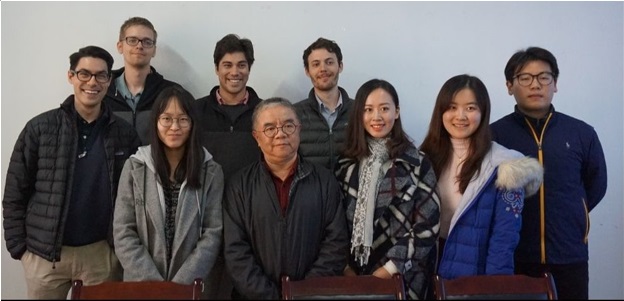In the first instalment of the Yunnan Research Series: As a part of their research trip, members of the Tsinghua-SAIS program were fortunate to visit the Ethnic Culture Research Institute, a subdivision of the Culture Department of Yunnan province. Located in a small office in a central Kunming high-rise, the Institute focuses on researching and preserving the traditional culture of Yunnan’s ethnic minorities. Among China’s 56 officially recognized ethnic groups, 25 are found in Yunnan, with minority non-Han groups composing 38% of the population. This makes Yunnan one of the most diverse provinces in the country.
In the office, the students were able to meet with four employees of the institute, including the director. They provided an overview of the Institute’s mission, and answer many questions. They explained the present situation of ethnic affairs in Yunnan. According to their presentation, all of the ethnic groups have been in the country for hundreds of years, and co-exist peacefully. There is no underlying tension between the Han and minorities, or between different minority groups, like that which troubles the Xinjiang or Tibet Autonomous Regions. Additionally, intermarriage between ethnic groups is common, and many of the groups are ethnic small, as few as a few thousand members. Therefore much of the ethnic work in Yunnan focuses on culture, not politics.
As part of their research, the Institute has published large books about the traditional art of Yunnan, with plentiful color photographs for a wider audience throughout the country. The book largely focuses on paint and craft based arts. The institute also works on understanding non-physical arts, particularly song and dance.
This led to questions on tourism in Yunnan. Yunnan’s tourist industry is rapidly developing, and is one of the fastest growing provinces in the country for tourist arrivals, particularly domestically. In 2015, 2.5 million domestic tourists visited Yunnan. The province’s attractions are primarily natural, such as the rice terraces, rainforest, and mountains, as well as historical, including the old cities of Dali and Lijiang. But minority culture has become a part of the tourist industry as well. Traditional dress, dance, and song are popular tourist attractions, and several Yunnan cities, including Kunming and Jinghong, have professional ethnic dance shows daily based on the local ethnicity’s traditions.
The experts at the Institute admitted that tourism has benefits and drawbacks for ethnic minorities. Tourism has brought significant new investments to many of Yunnan’s core cities, as hotels, shops, restaurants, and tourist agencies provide job opportunities for the local families. Before this boom in tourism, Yunnan was one of the most rural and least developed provinces in China, and remains well below coastal provinces like Shanghai in GDP per capita. Tourism also promotes better understanding of minority peoples among the Han, and a more widespread understanding of Mandarin, which helps to unify China across ethnic lines.
However, tourism does threaten some aspects of ethnic culture. Some cultural traditions which hold particular interest to tourists are presented as tourist attractions, even if they are inauthentic or no longer practiced. One example of this is the “walking marriage” attributed to the Mosuo people of northwest Yunnan; according to the common understanding, the married men only visit the wife at night, leaving in the morning and having no part in raising of the children. This leads to a matriarchal society where women hold social power. The Chinese media tends to sensationalize these aspects of Mosuo culture, hyping them as more prevalent and important than the experts believe they are in modern society. The Institute experts also stressed that it is often difficult for people to understand and properly contextualize social practices of minority groups, and that the media should avoid sensationalizing them as exotic.
In terms of authenticity, mass tourism can create the possibility for a sanitized, commercialized version of minority cultures. Rather than appearing as distinct peoples with hundreds of years of traditions and history, minorities can be presented as exotic novelties. For example, the old city of Lijiang has seen massive restoration and new development, with nearly all businesses catering to the tourist market. On a typical street of the old city, one can see a dozen shops selling the famous drums of the Naxi people. Traditional Naxi dress, previously worn for special occasions, Is worn daily by many Naxi in the tourist business. The city has as many characteristics of Disneyland as it does of an old Chinese city. Also, many tourist-specific businesses are owned and operated by companies from outside Lijiang, limiting the economic benefit for the locals somewhat.
Overall, the experts stressed that the economic benefits to the minority people outweigh these risks and negative trends, and that so far there has been little pushback from minorities against the tourism expansion. The negative consequences should be considered and mitigated, however, as the growth continues.
On a different topic, the experts also answered questions about religion in Yunnan. Many of the minorities are of different religions, including Catholicism, Buddhism, Islam, Taoism, and smaller indigenous faiths. The experts explained but that according to the laws of China, each technically has the right to practice its religious faith individually. On the subject of individual piety and religiosity, however, there is significant variance across different ethnic groups. For many of Yunnan’s minorities, they theorized that religion is more a part of ethnic heritage than everyday life. For example, Hui people are predominantly Muslim, Dai people are mostly Buddhist, and Derung people are mostly animist. These different faiths are interwoven into the culture and festivals of each minority, even as religiosity has declined throughout modern China.
Ultimately he experts, who had moved to Yunnan from other parts of China, were quite enthusiastic about discussing Yunnan’s ethnic diversity, and pursuing further research. The visit to the Institute was valuable for learning more about the cultural fabric of Yunnan province, and was a unique opportunity since much of the Yunnan trip focused on environmental issues.
